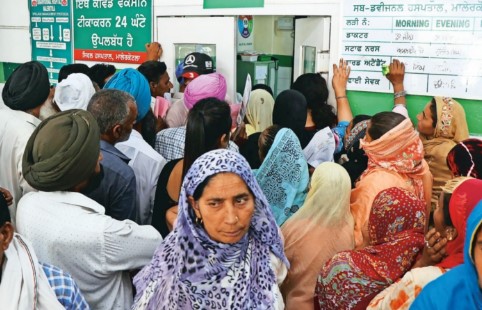Context:
A ‘Huge Gap’ in Cancer Screening Services at the Health and Wellness Centres (HWCs), according to a report from 13 states prepared by NITI Aayog.
Key Findings:
- Since its launch six years ago, the Ayushman Bharat insurance scheme has been accessed by over 5.47 crore individuals nationwide.
- The report, prepared by NITI Aayog’s Health and Family Welfare vertical in June last year 2023 but not yet made public, was shared with the Ministry of Health and Family Welfare.
- It outlines three distinct screening methods for different cancers:
- Oral visual examination for oral cancer.
- Visual inspection with acetic acid for cervical cancer, involving examination of the cervix after the application of 3-5% acetic acid.
- Clinical breast examination (CBE) for breast cancer among individuals aged 30-65 years.
- Despite plans to train Auxiliary Nurses and Midwives (ANMs) and other staff in these methods, the training has fallen short of expectations.
- Breast cancer screening involves educating beneficiaries on how to perform a self-examination.
- However, there has been no implementation yet for screening cervical cancer.
- Screening for oral cancer is conducted on a case-by-case basis, based on tobacco consumption habits or visible symptoms.
- It also noted that while NCD screening was underway at most facilities, annual screening was largely lacking.
- It also found that the HWC staff showed limited or no knowledge of the necessity for annual screening for hypertension and diabetes.
- Regarding infrastructure, the report indicated that HWCs generally met operational guidelines standards, with basic devices and medicines available free of cost.
- However, gaps in cancer screening are significant considering the government’s focus on early cancer prevention and detection.
About the Ayushman Bharat Scheme:
- It was launched as recommended by the National Health Policy 2017 and aims to achieve Universal Health Coverage (UHC).
- Fulfill the commitment to “leave no one behind” as per Sustainable Development Goals (SDGs).
- The scheme comprises two interconnected components:
- Health and Wellness Centres (HWCs)
- Pradhan Mantri Jan Arogya Yojana (PM-JAY)

Pradhan Mantri Jan Arogya Yojana (PMJAY):
- It is the world’s largest health insurance/ assurance scheme fully financed by the government.
- Provides coverage of up to Rs. 5 lakhs per family annually for secondary and tertiary care hospitalization across public and private empanelled hospitals in India.
- It aims to benefit over 13.44 crore vulnerable families, which includes approximately 65 crore beneficiaries.
- Comprehensive Healthcare: Promotive, Preventive, Curative, Palliative, and Rehabilitative aspects of healthcare.
Health and Wellness Centers (HWCs):
- It focuses on establishing 1,50,000 Health and Wellness Centers at the primary level.
- These centers were designed to deliver a variety of services, including annual screenings for individuals aged 30 years or older, targeting Non-Communicable Diseases such as hypertension, diabetes, as well as three prevalent cancers in India: oral, breast, and cervical cancers.
- Comprehensive Primary Health Care (CPHC): HWCs offer Comprehensive Primary Health Care, including maternal and child health services, non-communicable disease management, and free essential drugs and diagnostic services.

